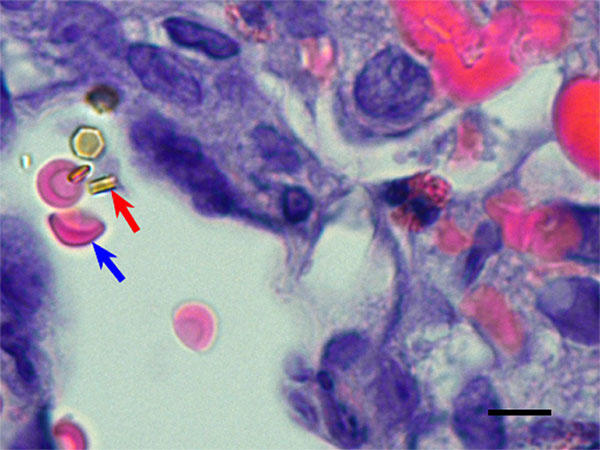Nanoparticle Generator Slips Chemotherapy Past Tumor Cells’ Protective Barriers
, by NCI Staff
Researchers have developed and tested a new injectable nanoparticle-generating technology that can deliver doxorubicin (Adriamycin®), a commonly used chemotherapy drug, straight to the nucleus of metastatic breast cancer cells with high effectiveness.
In the study, the treatment approach led to complete remissions in mice with a hard-to-treat form of breast cancer. The findings appeared in Nature Biotechnology on March 14. The research team that led the study hopes to start testing the treatment in human clinical trials by the end of 2017.
The effectiveness of most chemotherapy and targeted therapy drugs is limited by biological barriers that protect cancer cells, including the walls of tumor blood vessels and molecular pumps in tumor cell membranes, called efflux pumps, that eject toxic substances.
“Usually, less than 0.1 percent of drug molecules end up in the cancer tissue while over 99.9 percent of the drug molecules stay in healthy tissue,” said Haifa Shen, Ph.D., of the Houston Methodist Research Institute, a senior investigator on the study. “And when tumor cells receive [such] a suboptimal dosage of drug, they gradually adapt and develop resistance,” he said.
To increase drug potency and reduce the chance that cancer cells would develop drug resistance, the researchers developed a nanotechnology-based therapy, what they call an injectable nanoparticle generator (iNPG), that can shuttle a drug through the tumor vasculature, straight to the nucleus of tumor cells.
The iNPG is like a “mothership,” Dr. Shen explained, in which the researchers hide doxorubicin-containing nanoparticles called pDox. The pDox are long chains to which doxorubicin molecules are attached. Because of their size and shape, as well as other properties, he noted, the iNPG particles preferentially accumulate in the lungs and liver—primary sites for breast cancer metastases.
Once the iNPG particles reach the tumor vasculature, the pDox nanoparticles are released from the iNPG’s nanopores. Thermodynamic forces then cause the pDox chains to wrap up into balls, which makes them resemble exosomes—small membrane-bound sacs that are exchanged by cells. Disguising the nanoparticle as an exosome allows the drug to be taken up by tumor cells and to avoid their efflux pumps.
Once inside the tumor cell, the pDox particles eventually traffic to vesicles near the nucleus, called endosomes, where the high pH of the endosome causes the doxorubicin to detach and kill the cell.
The researchers tested the iNPG particles in mouse models of metastatic triple-negative breast cancer. Half of the mice achieved complete remission and lived disease-free as long as their healthy matched littermates. The other half eventually died of metastatic disease, but still lived much longer than mice treated with standard doxorubicin or liposomal doxorubicin (Doxil®).
“We were stunned when we did the experiment, and so we did it again and again,” said Mauro Ferrari, Ph.D., president and CEO of Houston Methodist Research Institute and senior investigator on the study. “It’s been 5 years’ worth of animal studies.”
This approach is a novel way to use nanotechnology, Dr. Ferrari emphasized.
“If we take the same [pDox] nanoparticles and inject them in systemic circulation by IV drip, they don’t have the therapeutic effect,” he said. “The key discovery was to make these nanoparticles after they reach the tumor microenvironment.”
Packaging the pDOX in the iNPG allows the drug to get past “biological barriers” that often prevent cancer drugs from accumulating in tumors, Dr. Ferrari continued, such as those that divert the drug to nontarget organs or prevent it from leaving the circulation and entering the tumor microenvironment.
Doxorubicin is one of the most widely used chemotherapy drugs. It is typically used to treat breast and ovarian cancers, sarcomas, and other types of cancer. But doxorubicin can damage the heart, so there's a limit to the amount of the drug that one patient can receive before they develop cardiac side effects, explained Dr. Shen.
In the study, at one week after treatment, mice that received the iNPG treatment had no evidence of the drug in cardiac tissue and no evidence of cardiac injury, while mice that received standard doxorubicin or pDox nanoparticles not packaged in the iNPG still had elevated levels of drug in the heart and damage to cardiac tissue.
“With this platform, we can change the biodistribution of the drug,” Dr. Shen said.
The approach “certainly represents an ingenious nanotechnology,” said Piotr Grodzinski, Ph.D., director of NCI’s Office of Nanotechnology Research. “It will be interesting to see if this strategy can be generalized and if particles can be engineered to target tissues besides the lung and liver.”
Dr. Ferrari and his colleagues are seeking permission from the Food and Drug Administration to carry out a phase I clinical trial, which they hope will start within the next 12 to 18 months, he said.
